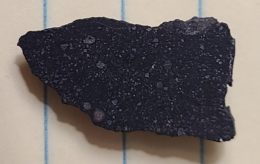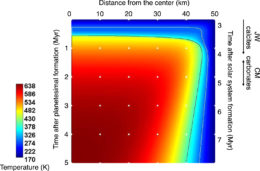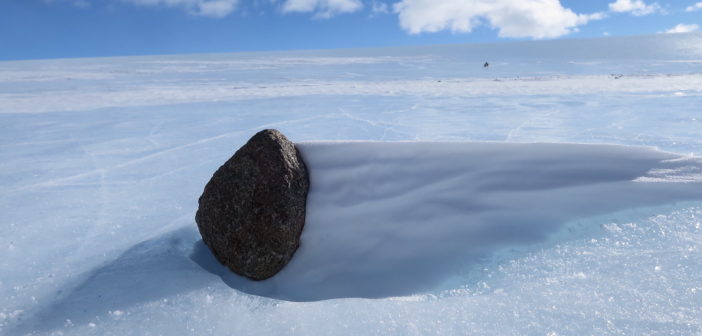Astronomers wait years for robotic explorers to bring back samples of asteroids — but sometimes, asteroids come to us. What can the meteorites that rain down on Earth tell us about their parent asteroids?
Bringing Outer Space Down to Earth

NASA scientist Peter Jenniskens spies an asteroid meteorite in the Nubian Desert in Sudan. The vast majority of meteorites are found in deserts, including Antarctica. [NASA/SETI/P. Jenniskens]
In a new article, a team led by Wataru Fujiya (Ibaraki University, Japan) analyzed a slice of the Jbilet Winselwan meteorite, a 6-kilogram carbonaceous chondrite found in Western Sahara in 2013. The team performed laboratory tests to determine the age and composition of the meteorite, as well as what minerals are present, providing clues as to the history of its parent asteroid.

A sliced fragment of the Jbilet Winselwan meteorite. [MJCato]
A Slice of Early Solar System Life
Fujiya and collaborators found that the meteorite contains calcite — a crystalline form of the main component of eggshells, pearls, and chalk — which forms only in the presence of liquid water. Using radioactive dating, the team determined that the calcite in their sample likely formed just 2.6 million years after the solar system formed, meaning that at that point in time, the parent asteroid was warm enough for ice to melt into a liquid.
In fact, the team found signs that the asteroid warmed up far beyond 0°C; some of the minerals had decomposed, which laboratory tests suggest happens at temperatures above 300°C. Space is much chillier than that — what heated this asteroid so quickly after the solar system’s formation?
Sun-Warmed Asteroids, or Something Else?

Modeled thermal history of the meteorite’s parent asteroid. The black and white lines mark temperatures of 0°C and 70°C, respectively. Note that the color scale in the figure gives the temperature in kelvin. [Fujiya et al. 2022]
As a test, Fujiya and collaborators modeled the thermal evolution of an asteroid heated by the decay of a radioactive form of aluminum. They found that 20% of the asteroid reached 300°C — hot enough to cause the mineral decomposition seen in the Jbilet Winselwan meteorite.
Additionally, their model showed that while the inner regions of the asteroid were warm enough to have liquid water 0.3 million years after formation, the exterior regions remained cool for a further 0.3–1.0 million years. This explains how dissimilar meteorites could arise from the same asteroid; the Jbilet Winselwan meteorite likely arose from the interior of its parent asteroid, while meteorites that are chemically similar but lack signs of heating might come from the exteriors of asteroids.
Citation
“Hydrothermal Activities on C-Complex Asteroids Induced by Radioactivity,” Wataru Fujiya et al 2022 ApJL 924 L16. doi:10.3847/2041-8213/ac448f

